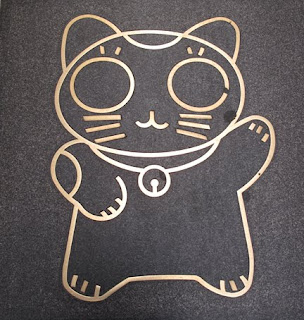Saihoji, more commonly known as Kokedera, is on of Kyoto's Unesco World Heritage Sites.
To enter this temple you must have a reservation made well in advance (about a month) by mail. You must have a Japanese address in which they can correspond. When receiving a response, you are told on what day and at what time you must arrive to visit the temple. The cost to enter the temple and gardens is about $30 US. It is well worth the money.
Kokedera offers the unique opportunity for visitiros to participate is some of the temple's religious activities. Every visitor is asked to contribute to the observances of kito and shakyo (respectively, the chanting and copying of Buddhist scriptures, called sutra). We participated in this activity and all I can say is that in doing so, you begin to feel a sense of calm and comfort that becomes even clearer as you make the small trek out into and around the gardens. After the copying of the sutras we offered them back to the temple at the alter. It took some time to accomplish this task but it was well worth the experience. I really enjoyed myself despite the fact that it took a bit of time to finish the writing. I found the activity to be meditative and quieting. I highly recommend you go if you ever find yourself in Kyoto. You do have to plan ahead though.
Kokedera which means Moss Temple, has an estimated 120 different varieties of moss. Visitors to the temple can walk through this spectacular garden. It's obvious upon first entering, that this garden has strongly influenced subsequent Japanese garden design. I must admit, that on the day we were scheduled to be at Kokedera, it was raining. It was spectacular none the less. I would love to visit again - possibly on a sunnier day.
Here is the entry way into the gardens.

And upon entering we came upon this beautiful cluster of cherry blossoms.

We happened upon this interesting structure. I wish I could tell you exactly what it is.

and we found ourselves following a lovely stone pathway.....

That lead us to another cherry tree amidst these beautiful surroundings.

here is a little stream that carved its way through some of the moss.

As you continue through into the garden you are enclosed in a pleasant atmosphere of soothing light (and in our case rain) leaking through the leaves. In an undulating abundance of green, there is the undeniable mossy carpet and huge trees throughout the garden.

there are moss varieties that have warm tones scattered throughout the soft light greens.

and more monochromatic too......

pillows of mossy softness make up the ground cover.........

and blanket all the way to the waters edge.

we continued our walk where we saw trees beautifully scattered around the pond

and here is a spectacular tree that is large and winding its way around another tree

and here we came upon a sacred tree....probably hundreds of years old..In the Shinto religion nature is sacred. To be in contact with nature is to be close to the gods and natural objects are worshiped as sacred spirits or kami.

and here a sacred stone...

here we came to an interesting triangular shaped spot that lead out to the water.

and we even saw some koi swimming around....but too quick for me to get any more then
its tail....I enhanced the water just a bit to add some contrasting color to the image.

and here is a wider view of the pond with its scattering of stones

a close up of a tree on its small little island with moss covered stones....

another perfect view.....

This scene just takes my breath away.....it exemplifies all that I loved about this place. The raindrops add to the romance of the image. Soft, luxurious and rich....

Another stunning view....The theme of the garden is centered on the pond because it is in the shape of "kokoro" a popular Chinese character for "heart". There is a common belief among the Japanese people that there are three islands inside the sacred pond named Horai, Tsuru and Kame which stand for the Buddhist idea of paradis. Yodomari-shi, the rock structures near the Horai Isle are regarded as anchored boats on the way to or from paradise. Nice......

as we approached the end of our time in the moss temple gardens we each wanted a photo of ourselves at this wondrous place. Here's one of Cliff

one of Makoto

and one of me.....

and off we went down a walkway

and look at a close up of the end of the stairway.....I love these formations

and then we came upon a stone with running water. This is most commonly used
to wash your hands before you pray or enter or leave a sacred area or shrine.

and lastly, I would like to leave you with these images....what a beautiful place.

I am in awe

I'm left with a peaceful feeling....hope you are too.































































